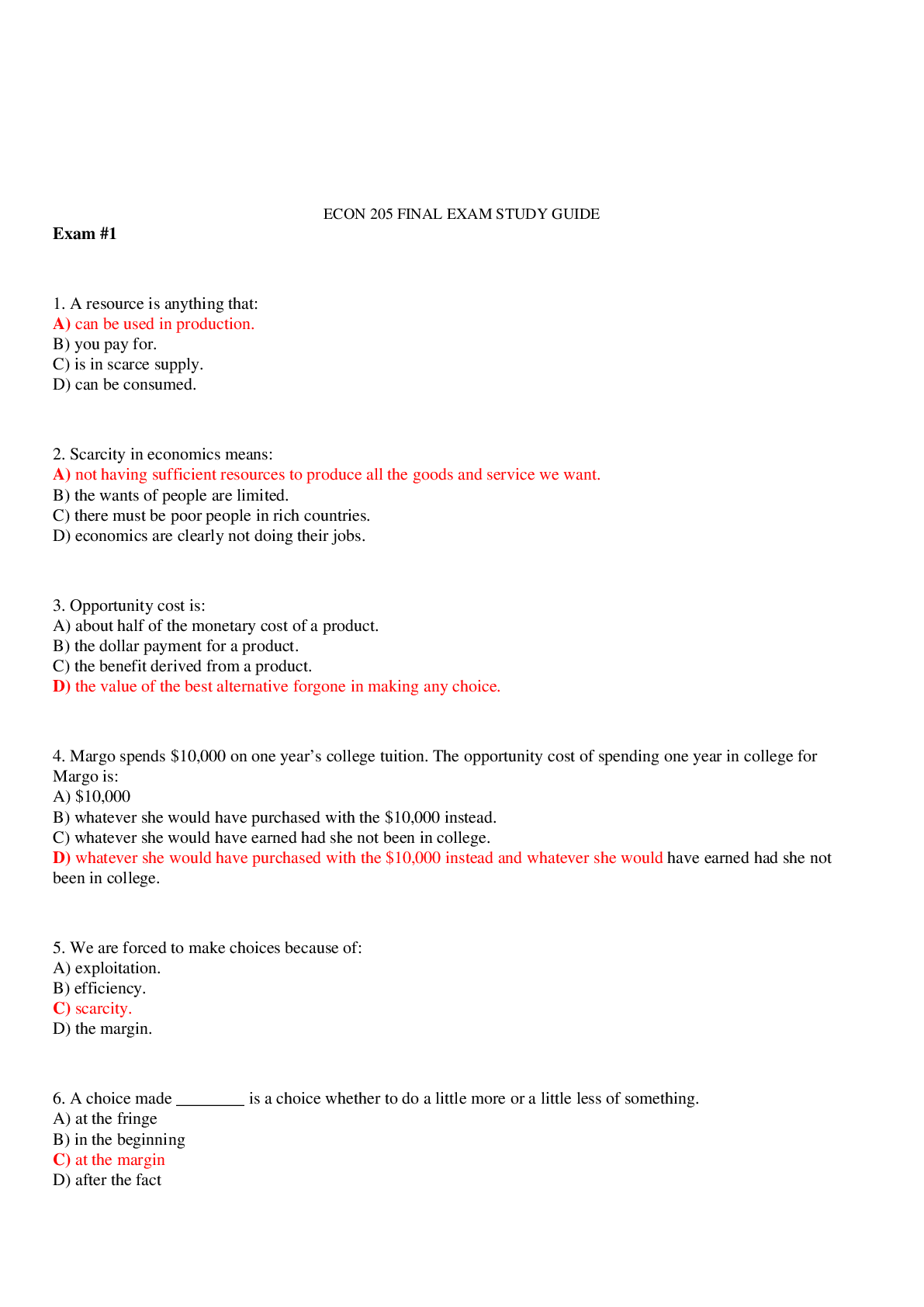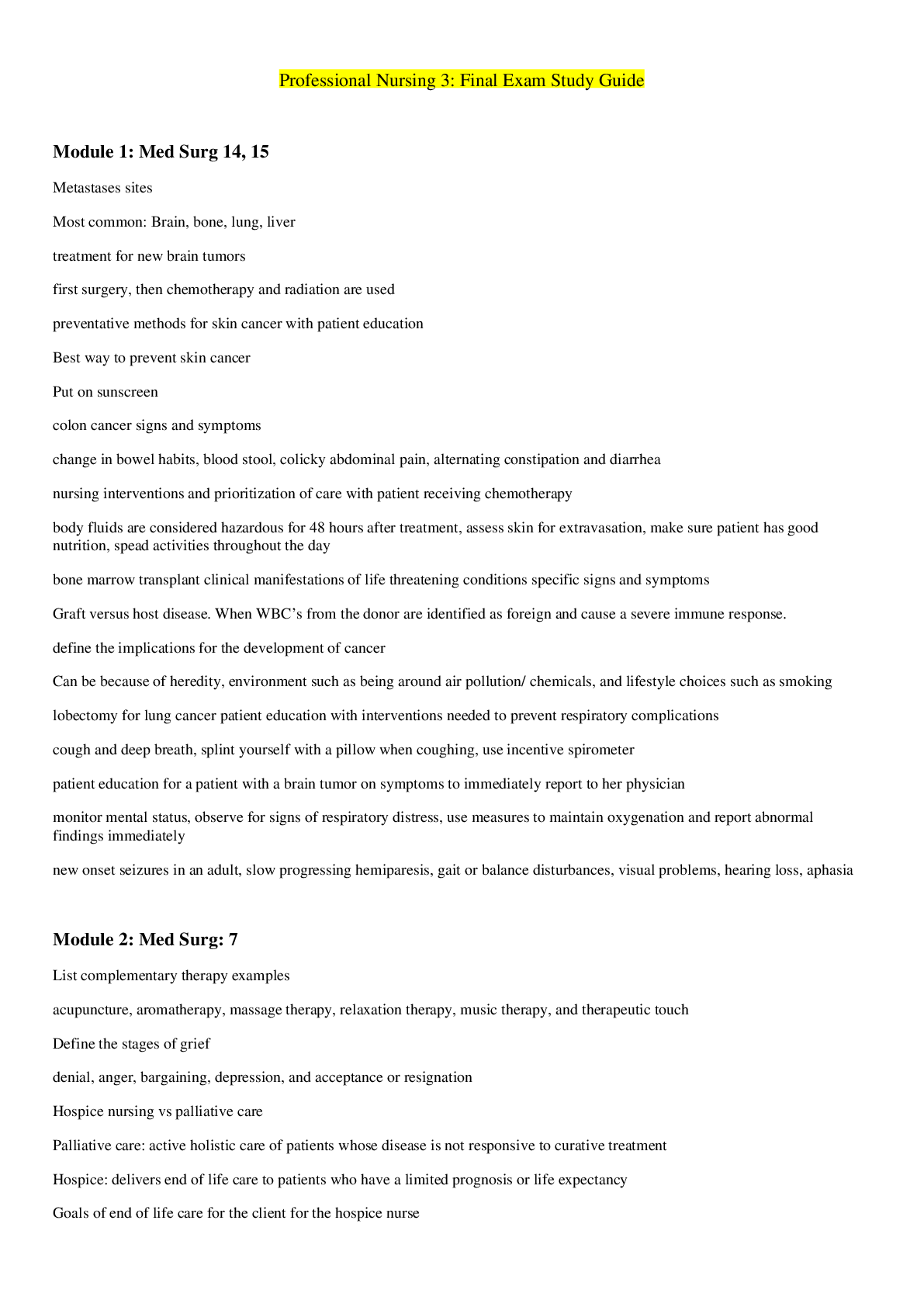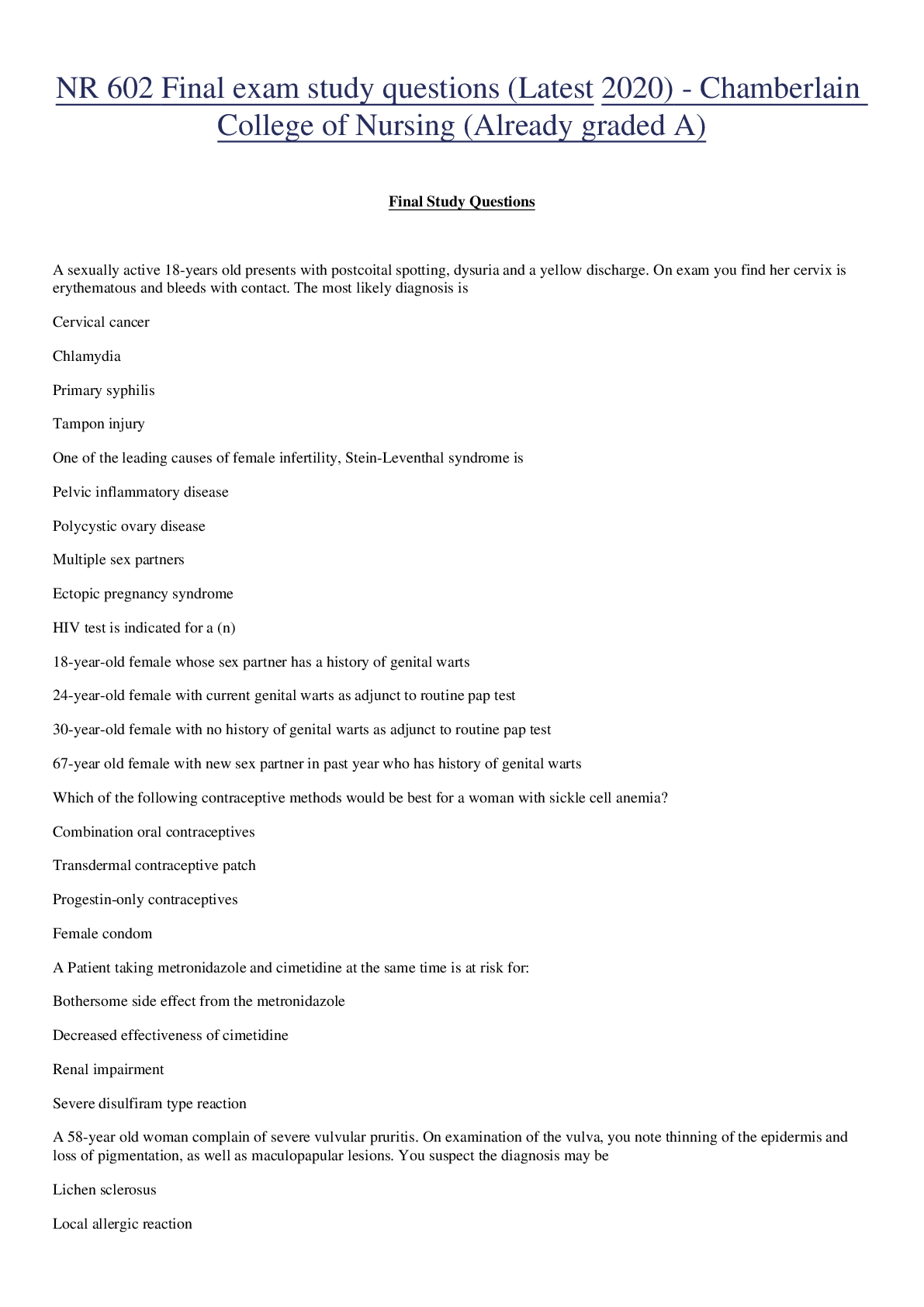NUR 2633: Maternal Child Health Final Exam Study Guide (Complete Guide )
Document Content and Description Below
NUR 2633: Maternal Child Health Final Exam Study Guide Final Work Sheet 1. Dysmenorrhea – a common complaint with women – what are the non-pharmacological and pharmacological treatments. NS... AID’s (Motrin, Naproxen, Alive), heating pad, rest, increase calcium, increase fluids, decrease red meat, alcohol, smoking drugs, exercise. 2. Obstetrical issues – pregnancy risks - Know Naegle’s Rule – to establish gestational age ovulation occurs in the middle of the cycle, stress can affect cycle, as well as high exercise, pregnancy, medications, drugs, hormones, obesity. Add 1 year, subtract 3 months, add 7 days. Pregnancy risks smoking, alcohol drinking, obesity, diabetes, drug use, hypertension, poor nutrition, eating disorders ALL affect pregnancy. EDD can also be measured by fundal height (Ex. Fundal height is measuring at umbilicus = 20 weeks) 3. Fetal assessment 3 things baby is okay – fetal heart tones (audible at 10-12 weeks), movement (16-18 weeks for multiparis, 18-20 for prima gravida), fundal height (12-14 weeks, at the symphysis pubis, umbilicus is 20 weeks) 4. Poor nutrition, drugs, HTN, DM are all issues of placental perfusion – what will the fetal result be – IUGR is the result, how do we identify IUGR? Smaller fundus. Uncontrolled diabetes = large baby, larger fundal height, baby can have hypoglycemia after birth, birth injuries and respiratory immaturity 5. Does the placenta provide nutrition? – no it provides for gas exchange, baby gets oxygen. 6. Anemia becomes a problem in pregnancy – can you discuss the maternal and fetal risks – low hemoglobin = low oxygen, baby with low oxygen means less movement. Iron ingestion can cause GI upset, tarry stools, constipation (increase fluids, fiber, stool softeners and exercise) 7. Hyperemesis – excessive vomiting that exceeds more than 3 months, at risk for fluid and electrolyte imbalance, manage by IV fluids and antiemetics (Zofran), small frequent meals, avoid trigger foods, carb snack 8. Hypertension – preeclampsia has specific symptoms – please know these as well as treatment modalities and nursing interventions – keep in mind Magnesium Sulfate nursing interventions – headaches, blurry vision, epigastric pain, bloated, edema, high BP, protein in the urine. Manage by bed rest, dim the lights, Mag sulfate 4g maintenance over 20-30 minutes’ bolus, maintenance 2g. Seizure precautions, and monitor baby, left side lying. For Mag watch for mag toxicity and respiratory depression, check for urine output, and deep tendon reflexes, vitals every hour. Lungs if have to deliver baby, use Betamethasone to help with lung maturity. No bolus fluids in preeclampsia. 9. Pre- term labor – define it; signs and symptoms, treatment modalities and nursing interventions – pelvic pressure, cramping, contractions, baby drop, lower back pain, increase urine output and vaginal discharge. Can be caused by dehydration or infection. Put on monitor, GIVE FLUIDS (Bolus Lactated ringers), FFN test before vaginal exam, LABOR IS NOT LABOR WITHOUT CERVICAL CHANGE. 2CM OR 80% effaced, start aggressively managing pre term labor with terbutaline (Causes maternal tachycardia, watch heart rate), if unsuccessful go to mag sulfate and use betamethasone. 10. Diabetes Mellitus – Type 1, Type 2 and Gestational DM all have issues that are common to all and specific to each. Note the concerns specific to each, management and fetal surveillance – type 1 concerned with cardiac, skeletal and CNS in baby, woman requires less insulin 1st trimester because of basal metabolic rate is increased, then needs progress over 2nd/3rd trimester. Monitor closely, babies at risk for sudden fetal demise, have mom monitor # of fetal movements. Type 2 concerned with controlling sugars, control by diet, and hypoglycemic/macrosomic baby. Gestational DM, same interventions as type 2 DM. 11. Define Macrosomia – and what are the risks – large baby, larger fundal height, baby can have hypoglycemia after birth, birth injuries and respiratory immaturity 12. What is an NST, and a BPP for whom would you recommend these tests? – Non stress test, to ensure fetal well being, if non reactive move to BPP, if BPP scores from 6-8 keep monitoring, if less that 6 start to think about delivering, hostile uterine environment. 13. Amniocentesis: when and for what reason? – taking fluids from the amniotic sac, checking for chromosomal anomalies, checking lung maturity. 14. Amniotic fluid surrounds the baby and has 5 functions – oligiohydramnios means? Polyhydramnios- what are you thinking? Temperature, cord and baby cushioning, allows free movement of baby, lubricant, lung development. Oligohydramnios is too little fluid poly is too much. Poly identifies with fundal height more than what it should be. 15. It is all about the placenta and perfusion – how do promote perfusion to the placenta, and what can interfere? (any disease or substance that interferes with vascular perfusion: HTN, DM, smoking, drugs, poor nutrition, etc.) – left side lying. 16. Know fetal heart rate monitoring – 5 parts and what does each tell you. (ie: accelerations are always positive, healthy babies) – baseline, variability, accelerations, decelerations and maternal activity. 17. Variability 3 parts – moderate, minimal, absent. Minimal can be sleeping, decreased perfusion, dehydration, mom hasn’t eaten in awhile, medications, DO NOT AUTOMATICALLY THINK DELIVERY. 18. Accelerations – always good (: 19. Decelerations 3 types – early (head compression), variable (cord compression), late (placental insufficiency) Interventions: reposition mom, O2, fluids, stop Pitocin, prolonged (perfusion issue, hypotension from epidural induction, continue fluids) 20. Know Normal Fetal heart rate, when movement occurs, and when you can palpate fundal height and begin measuring with a tape measure – 110-160. 21. If there is a non reassuring Fetal Heart rate – what are the nursing interventions? Change moms position, fluids... 22. Epidural anesthesia is common place, what needs to be completed before an epidural can be placed? What are the risks to mother and then to baby with epidural? - 23. Labor is a progression – we recognize change with behavioral and physiological changes. Vaginal exams are means to measure progress – do you understand what you are examining and what it means? Example – 5cm, 90%, -2 (what does this mean 5cm dilated, 90% effaced, -2 above ischial spines) – Labor stages: latent, active (4cm-8cm in 4-6 hours, contractions 2-3 minutes apart, watch for tachysystole) and transition (placental delivery, gush of blood 5-30 minutes, pressure, full feeling, and globular uterus, cord lengthens, MAKE SURE PLACENTA IS INTACT). Complete complete and zero means 10cm dilated, 100% effaced and at ischial spines, fetal monitor shows early decelerations b/c head compression BABY’S coming! 24. 2 huge reasons for bleeding in the third trimester – previa and abruption. Previa is not painful, abruption is. Previa dark red blood, abruption bright red blood. 25. Know the Stages and phases of labor – recognize some of the characteristics and what we would know with a vaginal exam. What nursing interventions should occur? 26. When labor is not progressing what are some of the non – pharmacological and pharmacological means to make a difference. – fluids, walking, rupturing membranes (recommend), bath, Pitocin (titrate very carefully 2 milliunits per minute, progress 2 milliunits every 30 minutes based on fetal coping and contractions), prostins, cervadil, cytotec. 27. Delivery of the baby and delivery of the placenta – what are the risks? – Hemorrhage 28. IUGR, causes, risks, how do you recognize this in the antepartum period? 29. What are the signs of placental separation - risks and nursing interventions? 30. Postpartum risks – how do we intervene if a patient has a postpartum hemorrhage – the initial response? – hemorrhage begin with fundal massage, breast feeding, nipple stimulation. Boggy can be caused by distended bladder (empty it), rapid or prolonged delivery, infection, mom on Mag Sulfate. Give Pitocin, methergine, cytotec and hemabate. 31. Newborn assessment – what is the first assessment? Then? Know APGAR…. And thermoregulation and the prevention of cold stress – 110-160 HR, RR 30-60, Temp 36.5-37.2, babies can not temp regulate, so use a warmer, wrap them in warm blankets, completely dry them, cover their head, brown fat assists with temp regulation, pre term and IUGR babies do not have brown fat. APGAR at 1 and five minutes. Respiratory distress = nasal flaring, sternal retractions and grunting 32. How do we keep babies safe in the hospital setting? Employees with ID badges, do not carry baby in hallway, wrist bands, HUGS bands, alarms on doors, doors with locks and keypads to unit 33. Physiological jaundice is common – how do you recognize this, the most common cause, and how do we handle Hyperbilirubinemia? What are the treatment modalities and risks of the treatment? – common in breastfed babies, babies with immature liver (IUGR/Pre term), phototherapy (cover eyes, keep diaper on, no oils or lotions, turn frequently, supplements, increase baby’s intake. 34. NAS – neonatal abstinence syndrome – that which a baby endures during withdrawal – what are the signs of NAS? What is the management of the NAS? – S/S: inconsolable, crying, irritable, tremors, skin breakdown, poor weight gain, diarrhea, exaggerated rooting, use scale certain number start meds (methadone, morphine) 35. Milestones of infancy – 6 mos. Roll from tummy to back, hands in mouth, grasp, babbling, weight should be doubled. Posterior fontanel 6-8 weeks, anterior 12-18 mos. 1 year, walking, sit up, triple birth weight, standing, words (no, mama, dada), solid foods, possibly whole milk, preferably formula if not breast feeding. 36. ICP in children – specifically infants. Know possible causes, nursing interventions, priority care – hydrocephalus, trauma, infections. Interventions: keep head elevated, monitor vitals, LOC, posturing. 37. Know informed consents – parents or legal guardians, have to be greater than 18 years or age, must understand and acknowledge risk and benefits (emancipated = prego woman, someone who is married, court ordered emancipated) 38. Communication with children and families. What are the general rules to communicate with everyone, and specifically children – on their level, tone, face scale, dolls or transitional objects, simple/concrete terms, honest, no shouting or standing over them, procedures in procedure time, take time to explain, parents and child life experts are the best tools to use in communication. 39. Play is important – know the different play methods seen by each group of children – parallel, solitary, cooperative, organized, onlooker. Regression normal in hospital setting b/c of stress due to loss of control, pain, changes to body image. 40. How do we communicate with children and respond to their fears – separation/ pain – toddlers have more separation anxiety. KEEP PARENTS AROUND. Use familiar objects, take time to explain things, allow for manipulation of equipment, allow them to make choices. 41. Pain management for children – both pharm and non- pharm management – morphine, possibly dilaudid, sucrose, non nutritive sucking, swaddling, music, guided imagery, kangaroo care. 42. Know Erikson’s theory and some of the characteristics of each group. Provide education regarding the unique characteristics that you find at each age. Keep in mind the challenges of hospitalization on the pediatric patient. 43. Discipline and limit setting – what is appropriate. Know families – and how they cope with stress – how do children cope with stress? Limit setting, time out, taking privileges away, reward. 44. Medication administration to children – lets discuss oral meds, IM, IV, Subq. Otic, ophthalmic, 45. What is the role of the child life specialist? communication 46. Neurological – seizures and LOC – using Glascow coma scare – remember airway is always first. Care of the child during and after seizure. 47. Autism 48. ICP signs and some causes? 49. Respiratory – croup syndromes, risks, how do we manage? Use only cool mist vaporizers due to risk of burns. Rest is promoted, some medications? Know these. Surgical interventions and sign to observe for? – cough, need rest, fluids and proper nutrition. Cool humidifier. 50. Why do children have more Respiratory infections? – shorter estacheal tubes. 51. Cardiac – nursing interventions? Rest? And circulation – know the care of cardiac Catheter – cyanotic = blue, acyanotic = not blue but blood is shunted back to lung to resp issues, cardiac cath if bleeding put pressure above cath area, lie still (may need sedation) 52. Epiglotitis – chin protruding, tripod, wheezing, bent over, don’t insert anything into mouth, offer O2, positioning and rest. 53. Children admitted with Congestive heart failure – nursing interventions, management – tripod if acyanotic (most common VSD), cyanotic (most common Tetralogy of Fallon) need knee chest position, may need surgery, IV therapy, pain management and rest. 54. Know Drugs usually seen in cardiac care – digoxin, Lasix, also steroids, as well as all obstetrical drugs for antepartum care, postpartum issues. 55. Endocrine system – diabetes what is some of the symptoms? How is it managed? – Educate children how to manage their disease, use orange on how to inject. 56. GI system – diarrhea, dehydration, constipation – recognize symptoms of each and management cautiously providing fluids b/c can cause ICP, resp/circulatory issues. Follow fluids by weight and use microdroppers. Don’t restrict fluids with diarrhea, constipation can be because events or obstruction. Fiber, increase fluids, exercise, IV therapy. Appendix, crohn’s disease, ulcerative colitis, GI related diseases in kids. 57. Renal – concern failure – what type of dialysis? Common urinary issues, presentations, causes, treatment – hypovolemic event, burns, dehydration, glomerulonephritis. Daily weights to monitor fluid shifts, 58. MS system: recognize care of a sprain vs fracture – then think through all the needs of the immobilized child. And why, and what are the nursing interventions? Difference between sprains/ fractures and education for both - RICE 59. Immunocompromised or suppressed children – what are the risks? How do we prevent risks? – protect from infection, hand washing, contact precautions. 60. Blood issues – sickle cell anemia, iron deficiency anemia, hemophilia – know symptoms and priority needs and management – hydration is key. Pain management, rest, monitor vitals, watch for dehydration and infection, avoid cold and contact activities, factor 8 or blood transfusions. Just don’t bleed lol. 61. Know how to manage blood administration – make sure the blood matches, stay and watch transfusion, stop if having a reaction, need consent, infuse slow, vitals, crossmatch, run with normal saline. 62. Cancer care – we move from curative to palliative care – what are some of the goals of palliative care? These children may be immunocompromised – or immunosuppressed – how do we manage? – hand washing, prevent infection, contact precautions, use chemo and radiation but not 1st choice, due to developing body and brain. 63. Chemo therapy has risks and side effects – name them and note nursing management of each 64. Grieving families – stages of grieve and how do we respond to family needs? - 65. Pre and post-operative care of the child with any surgery and then specific signs to watch for in respiratory issues, throat surgery, abdominal surgery, extremities, head. There are some similarities and specific needs of each – vitals, call light in reach, respiratory status, allow the parents in, HOB elevated, orient, pain assessment and management, neuro check, comfort measures, lung and heart sounds, wound check, bladder distention, listen to belly, fall precautions, nasal cannula (humidify it), LOC, educate, incentive spirometer. Tonsillectomy’s, adenoidectomy’s, appendectomy’s, fractures, debridement’s most common surgical procedures. 66. Forms of child abuse –and your Legal responses of a child maltreatment – report by chain of command, verbal, emotional, physical and sexual abuse. 67. Skin – each age has unique skin challenges – know them, how to treat and the risks. Burns are specifically difficult for children - think holistic approach – diaper rash, acne, bug bites, scrapes, lacerations, burns, diseases. Gloves and hand washing, control itching and scratching to prevent infection. Wound care, use restraints, they’re okay for safety and procedures, elbow or papoose. Severe burn assess AIRWAY, then fluids, shock, infection, pain. [Show More]
Last updated: 2 years ago
Preview 1 out of 10 pages
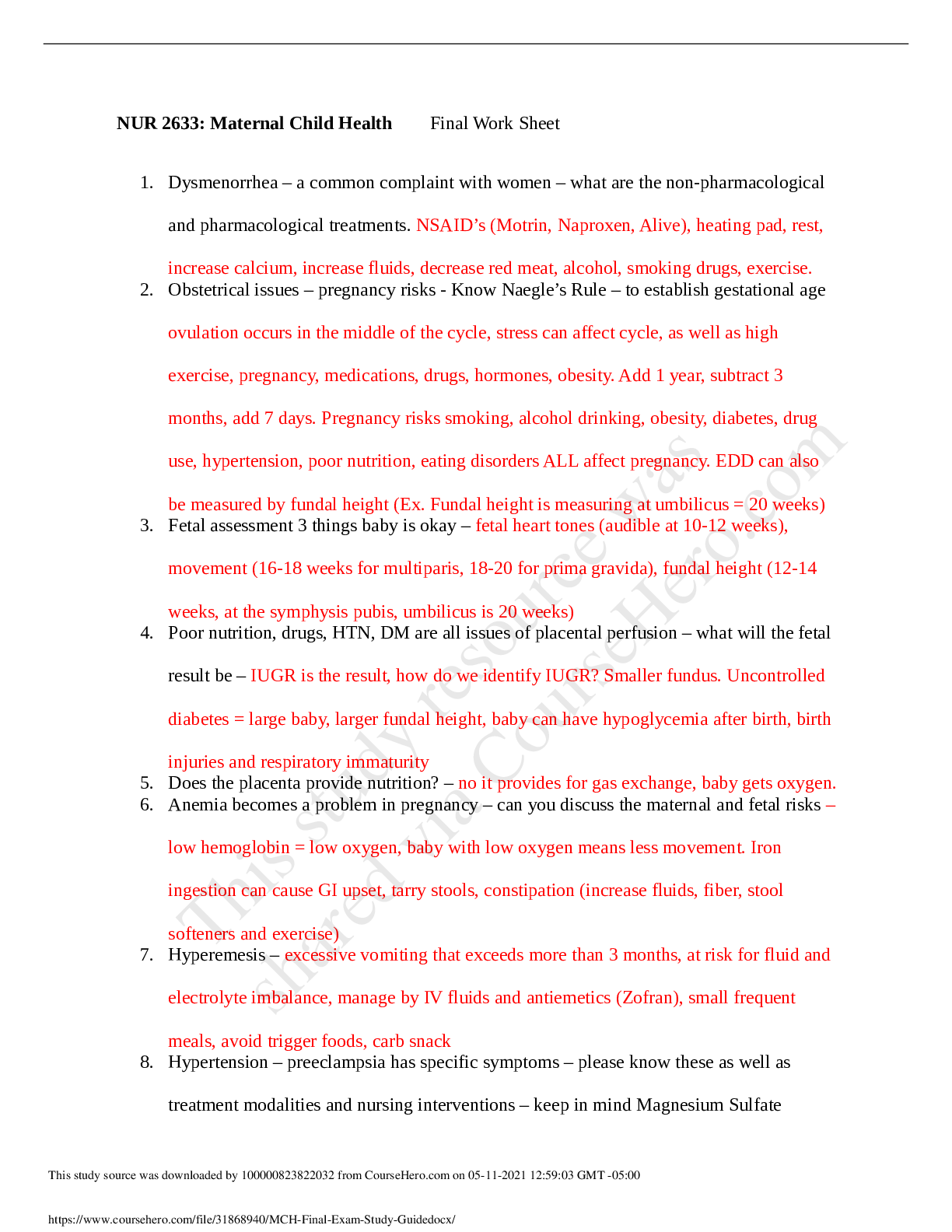
Buy this document to get the full access instantly
Instant Download Access after purchase
Buy NowInstant download
We Accept:

Reviews( 0 )
$15.00
Can't find what you want? Try our AI powered Search
Document information
Connected school, study & course
About the document
Uploaded On
Mar 09, 2021
Number of pages
10
Written in
Additional information
This document has been written for:
Uploaded
Mar 09, 2021
Downloads
0
Views
93

.png)





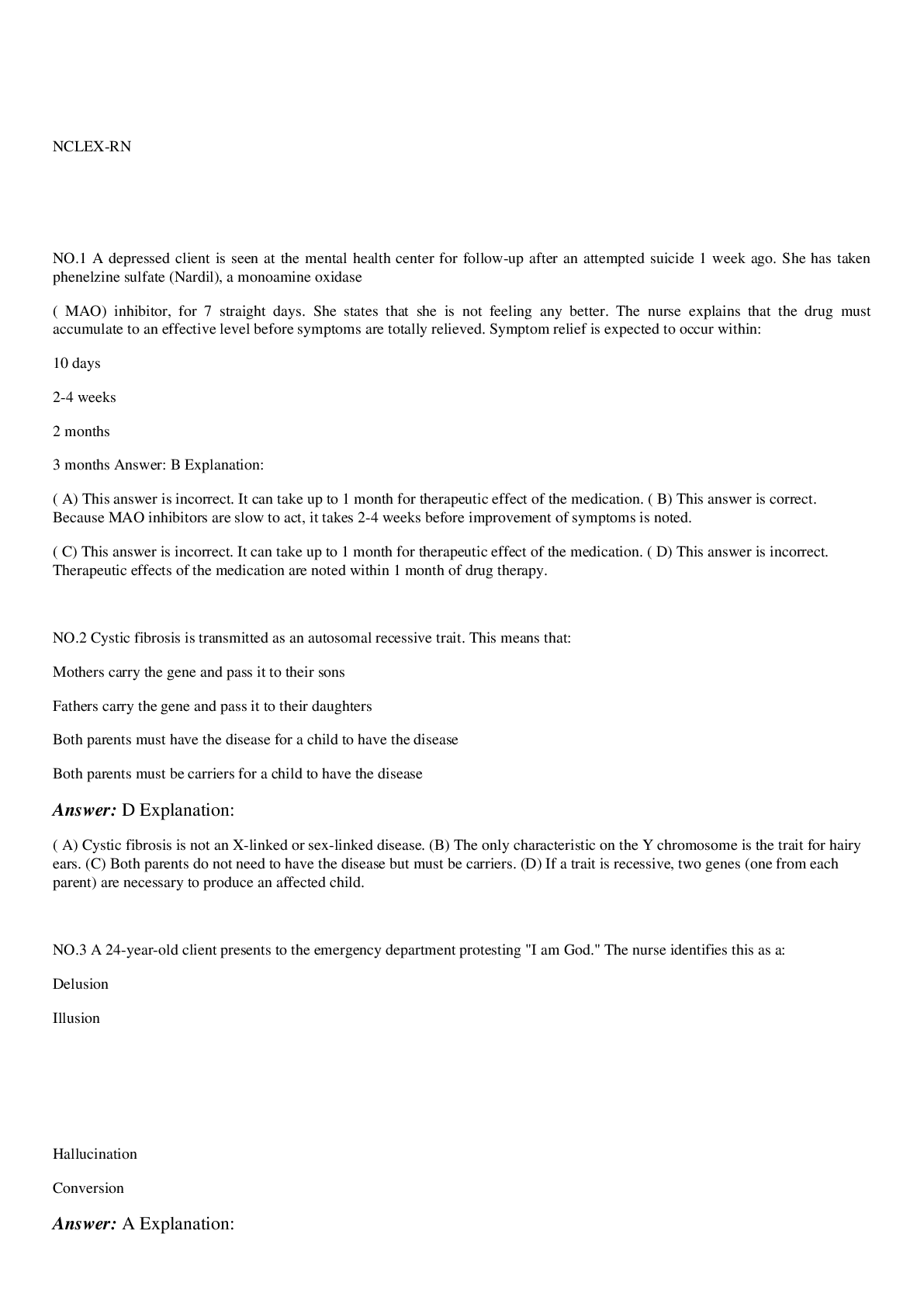
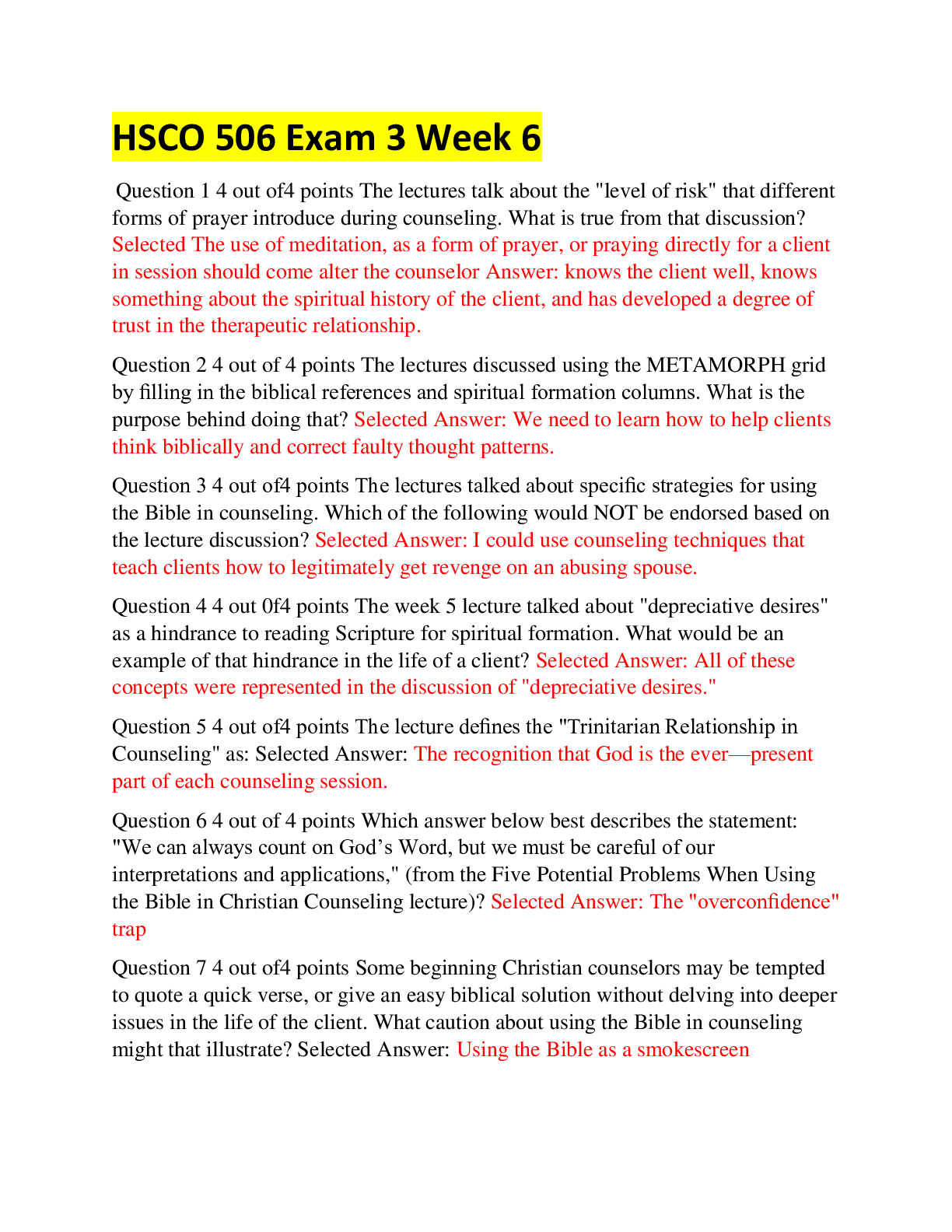

.png)


